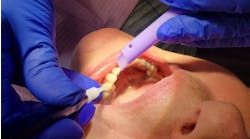By Marilyn Cortell, RDH, MS, FAADH
With extensive ongoing research in the scientific fields of immunity and inflammation, recent realization that oral infections, most prominently periodontal disease, may have powerful and multiple influences on the occurrence and severity of systemic conditions and conversely systemic conditions may impact oral disease. It is understood that our body possesses a unique and complicated system of immunity that guards us against viruses, bacteria, toxins and parasites. When organisms gain access into our body, they set off an attack, and in turn, activate the host immune and inflammatory response. The oral cavity contains its unique complement of protective mechanisms that include saliva, gingival crevicular fluid, epithelial cells and normal flora that contains approximately 500 species of microorganisms.
With extensive ongoing research in the scientific fields of immunity and inflammation, recent realization that oral infections, most prominently periodontal disease, may have powerful and multiple influences on the occurrence and severity of systemic conditions and conversely systemic conditions may impact oral disease. It is understood that our body possesses a unique and complicated system of immunity that guards us against viruses, bacteria, toxins and parasites. When organisms gain access into our body, they set off an attack, and in turn, activate the host immune and inflammatory response. The oral cavity contains its unique complement of protective mechanisms that include saliva, gingival crevicular fluid, epithelial cells and normal flora that contains approximately 500 species of microorganisms.
Moreover, the body contains its own complement of defense mechanism that include the skin, respiratory tract, alimentary canal and white blood cells (WBC), also referred to as infiltrating cells, most specifically neutrophils/polymorphnuclearleukocyte, (PMN’s) and monocytes. An effective immune response strongly depends on the ability of WBC’s to travel from one location to another in the body without delay. To accomplish this, infiltrating WBC’s produce cytokines that render blood vessel walls more permeable and enable WBC’s to exit the vascular walls and accumulate at a specific site. This process is known as Leukocyte Chemotaxis and is a critical cellular function of the body's defense immune and inflammatory response.
Studies of cytokines such as Interleukins, Tumor Necrosis Factor, Prostaglandins and Matrix metalloproteinases (MMP’s) along with C-Reactive Protein (CRP) have provided great insight as to how the body’s immune system functions in the presence of inflammation. While acute inflammation initiates a rapid immune response defending the body and restoring homeostasis, it is the chronic and pervasive inflammation that is believed to cause destruction and by which autoimmune diseases are often recognized. For example in Multiple Sclerosis (MS), there are many areas of plaque/biofilm present along the axon of the neuron in the CNS. Cytokine activity along the nerve is complex leading to damage of the myelin sheath that, over time, will affect walking, balance, speech, coordination and vision. MS is a chronic Inflammatory autoimmune disease characterized by elevated cytokine levels and inflammation. There is optimism that advances in new drug therapies will modulate cytokine function and reduce the inflammatory component in MS and other inflammatory diseases.
(Image courtesy of National Institute of Allergy and Infectious Diseases)CRP, although prominent in indicating levels of inflammation in the body, is non-specific as to where inflammation may be present and also may not consistently demonstrate elevation when the disease or condition is not active. However, it is being used to screen presumably healthy people along with those demonstrating signs and symptoms of diseases such as, but not limited to, respiratory disease, rheumatoid arthritis, systemic lupus erythmatosus, diabetes, inflammatory bowel disease, and cardiovascular disease. Even today well-known systemic conditions are being identified as possessing an inflammatory component such as some cancer types, psoriasis, fibromyalgia, depression, and others presently in the center of research.It is clear from long-term studies that periodontal ddisease is inflammatory, cyclic and sporadic, not linear as previously thought, and elicits an inflammatory response by the body. To this end, pro inflammatory mediators and elevated CRP is found in active periodontal disease sites. According to an article that appeared in the Journal of Vascular Research, December 16, 2010, the microorganism Porphyromonas Gingivalis, along with Interlukin-6, were found in the coronary arteries and concluded that periodontal disease infection might be contributing to coronary atherosclerosis. Periodontal disease, although silent, can be treated, controlled and managed when properly diagnosed. Until the time when the medical community is convinced that oral disease and systemic health have a strong connection, and therefore encourage patients to seek comprehensive oral care, the dental hygienist will continue to be vigorous in tailoring individual treatment plans and reinforce that achieving optimum oral health may lead to improved systemic health.
Marilyn Cortell, RDH, MS, FAADH, is a full-time Associate Professor in New York City College of Technology Department of Dental Hygiene. In addition to her teaching schedule, she provides specialized scientific courses, writes articles for journals and has contributed to three leading textbooks. Visit her website at www.cortellpresentations.com.










